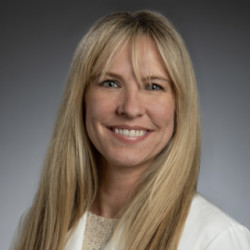As a neonatologist, I have an intimate relationship with loss. The death of infants is a sadly common reality in our profession, and I try to weather it with grace. However, there are times when I am shocked not just by death, but by the inability of clinician teams to provide support and comfort to grieving parents; that in institutions where death is a real and possible outcome, palliative care is absent. Though I understand time is limited, I feel that this is a crucial gap in our medical system that demands improvement. Below, I share a story of a time when I felt more could have been done for a mother, and discuss the various ways we can be better physicians for our patients and their families.
***
The patient is lying on the OR table, in helpless crucifixion. Her arms are splayed out and tied to rests. Her forehead is a ladder of wrinkles. Her eyes are empty and forlorn. The sides of her mouth curve imperceptibly downward.
She takes a large breath. The anesthesiologist bends forward and exclaims, “It’s normal to feel short of breath … it’s just a sensation.” But the patient’s rapid heart rate and quick, shallow breathing betray the fear she is trying to tame. Although she carries two premature infants, one died days ago and the other is fighting for its life. She closes her eyes and turns her face away. No one is holding her hand.
I introduce myself to the patient. The obstetrician, who has been standing between her widened legs waiting for a change, walks around her toward me. He says, “You need to talk to her. She wants to do a C-section for the remaining twin.” I clarify, “You need me to counsel her on prematurity and the expected morbidities for a 23-week twin?” because as a neonatologist, it is not my decision whether to section a mother or not. “Well, no. I already told her it is a great risk for her to do a C-section for a periviable infant. I think she needs to hear it from you, too.” He walks back toward her before I have the chance to respond. I step outside the OR briefly to collect myself.
A minute later, back in the OR, I see the patient’s husband walk in and lean over his wife. They speak quietly; I hear a jumble of words that I do not recognize. She closes her eyes as if to will this all away, as if to blink herself back to the peaceful sleep she was enjoying two weeks ago, when her babies lay squeezed against one another within her, their hearts beating loudly side by side. She opens her eyes and fixes them on a distant point, lost and forlorn. Her husband straightens his back and tells the OB, “No C-section. She will not be getting a C-section.” The patient turns her face away from him with resignation. From her EMR, I know that this is her ninth failed attempt at children. A quiet tear strolls sideways across her left cheek, landing in the soft padding of her ear.
The OB removes the monitors connected to her protuberant belly and turns the machines off. He again walks around the OR table toward me, this time removing his sterile gown and gloves. He says, “Thank you for everything. We no longer need to monitor if we will not be proceeding with a C-section.” I nod with sad understanding, look once more at the woman whose soul lies crumpled in a heap, and push the OR door open.
As I head out, I notice something: a steel table in the back left corner of the room, covered with the familiar infant blankets all hospitals have. On top sits a large metal bowl with a blue sterile towel draped across its top. The OB catches me staring at the shiny bowl and meets my eyes. He softly whispers, “The twin was born while you were in the hallway,” while he darts his eyes in the direction of the bowl. Time stops; my breath is trapped in disbelief. We’d been waiting for days for the deceased sibling to come. I look at him in astonishment and ask, “Did she not want to meet him? Did she want to see him? Did anyone ask?” He looks at me with sadness in his eyes. “Unfortunately, we did not ask her. We did not have time to ask her beforehand. We should have.” He swiftly turns on his heel as if to shield something he does not want me to see, and walks back to his position near the mother’s legs.
I turn my head back to the bowl. Is the baby in there? Then I look back toward the center of the room. Seven pairs of eyes are unwaveringly focused on the mother. What about this little life? I return my focus to the bowl. I take one, then two, then three steps. I reach out and slowly peel back the blue towel. In that moment, the lights dim in the periphery of my mind as the world around me stretches and tilts. There he is, a tiny little body of what used to be, arms and legs crossed, not ready to embrace the world. Not ready to be embraced by the world. Looking at him, all I can think about is loneliness.
In the ensuing 12 hours, the mother lost the other infant. I felt more loneliness, more shame. For being part of a team that failed her. For being part of a system that focuses on outcome rather than process. For abandoning her on her journey.
***
This experience was not one I would soon forget. As it unfolded, I came to a stark realization: that not all hospitals “able” to deliver periviable newborns are equipped with the necessary multidisciplinary services to sustain these little lives. High-risk pregnancies and extremely premature infants mean increased morbidity and mortality — thus, it’s alarming that there is not a palliative care team required in institutions that care for these complicated patients.
From a systemic perspective, had the mother had access to such a team, she would have benefited from increased psychosocial, spiritual, and medical support. In the first moment she arrived at the hospital, when she presented at 22 weeks gestation with decreased movement of one of her babies and the obstetrician confirmed no fetal heart tones, a palliative care physician should have been notified. But there was none. Often it is not possible to admit a high-risk mother to a high-risk medical center, simply because these are few and far between. But this mother was admitted to just a center.
And there was more we could have done, as well. From a humanistic perspective, I believe that once one of the twins passed away, a physician — whether it be on the obstetrical service or the neonatal service — should have spoken to the mother regarding what to expect. For example, that the infant could remain inside for many days. That while it did so, it increasingly placed her at risk of going into labor and delivering the live twin prematurely as well. That the longer the deceased fetus stayed inside of the mother, the less it would look like itself when it was ready to come out. Perhaps gently informing the mother of what to expect could have given her ownership of that memory, which is one she would have for the rest of her life.
And from a personal standpoint, there is more that I myself could have done. I could have stood by her. Put a hand on her shoulder. Held her hand, wiped her tears, sat near her while she wore a heavy gown of grief. But I didn’t. When the obstetrician told me he no longer needed my assistance, I felt deflated and useless. Like a spare appendage without a function, without one appropriate word to say. Yet I didn’t have to leave. I could have stayed. I didn’t have to talk. I could have just been present. And I think this is one of those things I have to continue to remind myself of over and over: it’s not about the outcome. It’s about the journey.
The literal meaning of compassion: to suffer with.
What changes do you want to see in your institution, and in health care at large? Share in the comments.
Dr. Giulia Faison is a neonatologist and budding bioethicist in Southern California. She enjoys yoga, running, and recently has picked up surfing. As a mom of four, exposing her children to the world is a priority. Dr. Faison is a 2023–2024 Doximity Op-Med Fellow.
Illustration by Jennifer Bogartz







